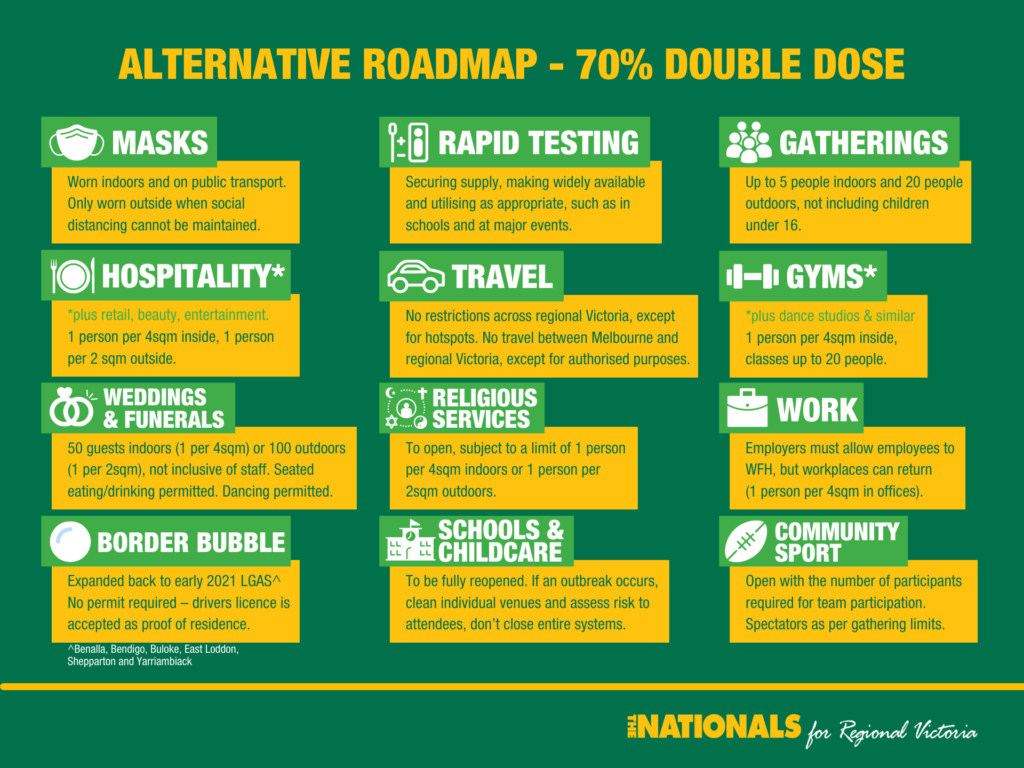Fair freedoms for regional Victorians at 70% of 16+ fully vaccinated
Reopen regional Victoria (for all) at 80% of 16+ fully vaccinated
Rapid testing to be available and utilised, as appropriate
On 4 October 2021, Melbourne became the most locked down city in the world. Victorians have lost hope. This has been magnified by the state stumbling at the first hurdle, missing the predicted deadline to achieve Phase A of Labor’s roadmap by three days. Victorians will have to wait until Phase D (tentatively expected to be reached at Christmas) to finally be able to have 30 visitors to the home. But there are no guarantees.
Mismanagement of the virus in Victoria has hampered people’s lives, businesses and mental health worse than anywhere in Australia, and, indeed, across our globe. Failures in the Government’s own state-managed COVID response systems have led to the lockdown of millions of Victorians. It’s recently prompted WorkSafe’s to lay charges on the Department of Health for last year’s failures in hotel quarantine.
The Nationals believe that Labor’s roadmap is too slow and does not acknowledge or reward the sacrifice and hard work of regional Victorians, particularly when compared to New South Wales and considering that many communities have worked to avoid COVID-19 completely.
The Nationals’ Alternative Roadmap
Victorians need confidence that the worst is behind them. That is why our plan will deliver certainty for the way out of restrictions – no ifs, no buts, no indicative easings, no being subject to change. The Nationals will stay true to our promises.
Our alternative roadmap for regional Victoria is consistent with the National Plan. It is comparable to the New South Wales roadmap, which relies on the Doherty Institute’s health modelling. Our roadmap ensures all Victorians are safe as we begin to reopen, rebuild, and recover from the pain caused during this pandemic.
Fair freedoms for regional Victorians at 70% of 16+ fully vaccinated
This phase of our roadmap only applies to fully vaccinated people, to those under 16 years of age, and to those with medical exemptions. The list below reflects the most critical changes to Labor’s roadmap that The Nationals believe will make our reopening fairer.
These alternative restrictions are consistent with the National Plan, modelling from the Doherty Institute, the New South Wales roadmap, and advice on schools from the Murdoch Children’s Research Institute.
Reopening regional Victoria (for all) at 80% of 16+ fully vaccinated
Throughout the pandemic, regional Victoria has led the way in both how to keep the virus out of the community and how to get vaccinated. Our regions should no longer be shackled to the case load and vaccination figures of Melbourne. If an outbreak occurs, restrictions should be limited to the affected hotspot, not the entire state.
While it took too long for The Nationals to be heard, LGA-by-LGA lockdowns have finally been adopted by the Government to manage outbreaks in regional Victoria. That approach should continue, albeit much less often as vaccination thresholds are reached.
Should regional Victoria reach the threshold of 80% of 16+ fully vaccinated before metropolitan Melbourne, The Nationals believe that the regions should move to the next phase of our roadmap without having to wait for the metropolitan Melbourne to catch up. This incentivises regional Victorians to get vaccinated and assists with our recovery.
This is consistent with the National Plan, as is our commitment that unvaccinated Victorians will not be subject to specific restrictions once we hit that 80% threshold.
Rapid testing to be available and utilised as appropriate
The Nationals have been on record in support of rapid testing being added to our toolkit against COVID-19 as an additional protection for Victorians. We welcome the TGA’s recent announcement that they will be approving individual testing kits for use from 1 November 2021.
Under our alternative roadmap, Victoria will deploy rapid testing for use in appropriate settings, such as in schools, health care, major events, and essential workplaces.

